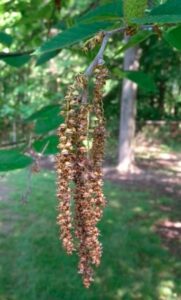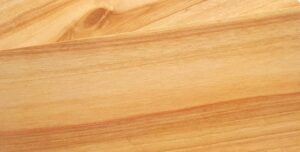The tree:

Yellow birch
Yellow birch is also known as the golden birch due to its bark which is a shiny yellow-bronze which flakes and peels in fine horizontal strips.
Note that the famous birch bark used throughout pre-history and history to make canoes comes from the white birch, not the yellow birch.
Betula alleghaniensis is the most prolific of species in North America. Its name relates to the Allegheny mountains where it is prevalent.
It is the provincial tree of Quebec where it is commonly called merisier, a name which in France is used for the wild cherry.
There are many variations of birch, but yellow birch is the best for woodworkers and the most commonly available.
Yellow birch is long-lived, typically 150 years and some old growth forest specimens may last for 300 years.
It is a medium-sized, typically single stemmed, deciduous tree reaching 60–80 feet (18–24 m) tall, exceptionally to 100 ft (30 m), with a trunk typically 2–3 ft (0.61–0.91 m) in diameter, making it the largest North American species of birch.

birch male catkins
Reproduction:
Yellow birch is monoecious. That means that you will find separate male and female flowers on the same tree.
Male flowers (staminate) occur in a cluster of 3 to 6 reddish-green catkins, that appear near the ends of twigs in the fall.
In the spring elongate forming hanging clusters up to 3 – 4 inches long while taking on a yellow-purple color.

Birch leaf & female catkins
Female flowers (pistillate) appear with the leaves and are reddish-green upright catkins, about 3/4 to 1-1/4 inches long at maturity, back of the tip on the same twigs.
The seeds germinate best on mossy logs, decaying wood or cracks in boulders since they cannot penetrate the leaf litter layer.
This can lead to odd situations such as yellow birches with their roots growing around a tree stump, which when it eventually rots away leaves the birch standing atop stilt-like roots.
Wood qualities and uses:

Birch “sandwich boards”
Yellow birch has a diffuse-porous heartwood that has a colour golden-brown to light reddish-brown often used as an alternative to maple. Its hardness is considered moderate. Its grain is often wavy. It has good characteristics for holding nails and screws and is resistant to splits. It is considered a good wood for bending. It is used extensively for furniture, flooring, doors, and cabinetwork, and is in demand for veneers and plywood.
As for me, I like its reddish-brown color once oiled and I use this warmer tone to complement the creaminess of maple and be a companion to the dark coffee hues of the walnut. It is a wood that I want to learn to bend.
Sustainability:
There is no threat to yellow birch.


